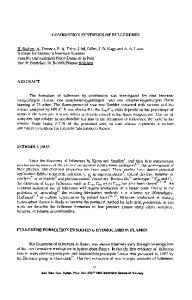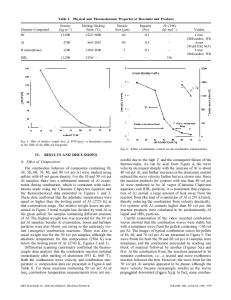Influence of Laser Vibrational Excitations of Ethylene Molecules in Laser-Assisted Combustion Diamond Synthesis
- PDF / 1,019,324 Bytes
- 6 Pages / 612 x 792 pts (letter) Page_size
- 32 Downloads / 335 Views
Influence of Laser Vibrational Excitations of Ethylene Molecules in Laser-Assisted Combustion Diamond Synthesis L.S. Fan1, Y.S. Zhou1, M.X. Wang1, Y. Gao1, L. Liu1, J.F. Silvain1,2 and Y.F. Lu1 1 Department of Electrical and Computer Engineering, University of Nebraska-Lincoln, Lincoln, Nebraska, 68588-0511, U.S.A. 2 Institu de Chimie de la Matière Condensée de Bordeaux – ICMCB-CNRS 87, Avenue du Docteur Albert Schweitzer F-33608 Pessac Cedex – France. ABSTRACT Laser-induced vibrational excitation of ethylene molecules was integrated to the CVD diamond deposition process for an in-depth understanding of the energy coupling path in chemical reactions and an alternative method to enhance the diamond deposition. On- and offresonance excitations of ethylene molecules were achieved via tuning the incident laser wavelengths centered at 10.532 µm. With the same amount of laser power absorbed, the chemical reaction is highly accelerated with on-resonance vibrational excitation whereas energy coupling with off-resonance excitations was less efficient in influencing the combustion process. The diamond deposition rate was enhanced by a factor of 5.7 accompanied with an improvement of diamond quality index with the on-resonance excitation at 10.532 m. The measured flame temperature demonstrated that the resonant vibrational excitation was an efficient route for coupling energy into the reactant molecules and steering the combustion process. INTRODUCTION Diamond is of great interests in industrial applications and scientific research due to the best and most extreme properties.1 In conventional CVD diamond methods, reactant molecules are indiscriminately thermally activated near thermal equilibrium.2-5 Energy is first deposited to the translational modes, and then finds their way to the internal modes (rotation, vibration, and electronic excitation) in the gas system. The conventional thermal activation is an inefficient route to drive gas reactions. Chemical reactions take place when chemical bonds are broken in reactant molecules and new bonds are formed in the products.6 Resonant vibrational excitations of reactant molecules could be more efficient in energy coupling than global thermal heating.6-8 Laser-assisted CVD takes the advantage of matching the laser light wavelength to the energy difference for a specific transition in precursor molecules. In this way, reactions can be promoted with a high energy-coupling efficiency and desired yield.8 Subramaniam et al. reported successful synthesis of diamond via pumping CO molecules to high vibrational states using a continuous-wavelength (CW) CO laser operating on its lower vibrational transitions.9 However, a low production rate rendered it unpractical for industrial applications. In this study, influence of laser excitations on diamond growth was studied using a wavelength-tunable CO2 laser. The CH2-wagging mode of ethylene (C2H4) molecules has a strong infrared activity and matches one CO2 laser emission line, 10.532 m. As the laser wavelength was tuned around the resonant w
Data Loading...











